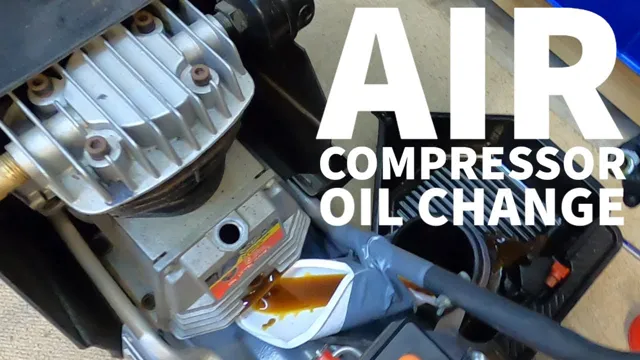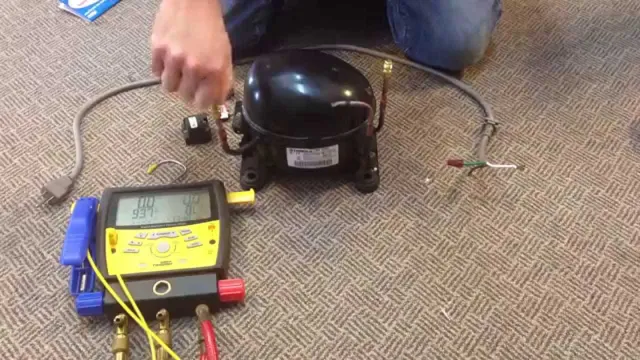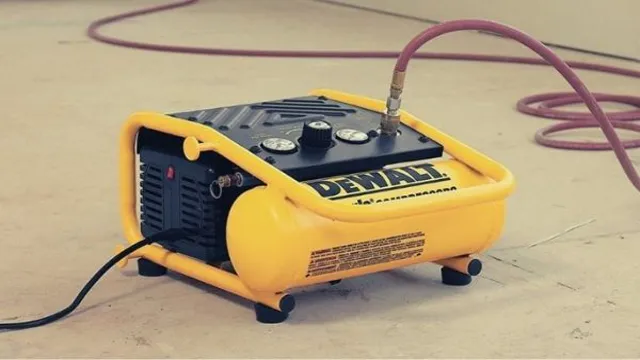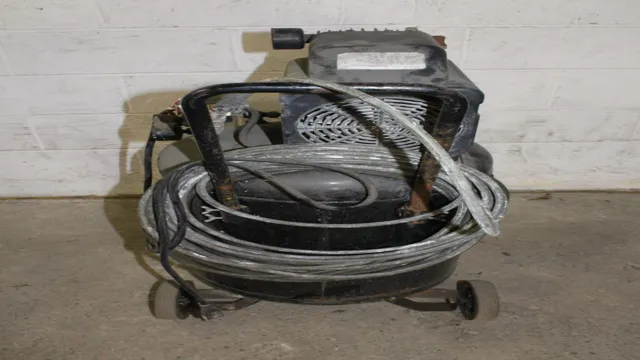How a Air Compressor Works: A Comprehensive Guide to Understand the Mechanism
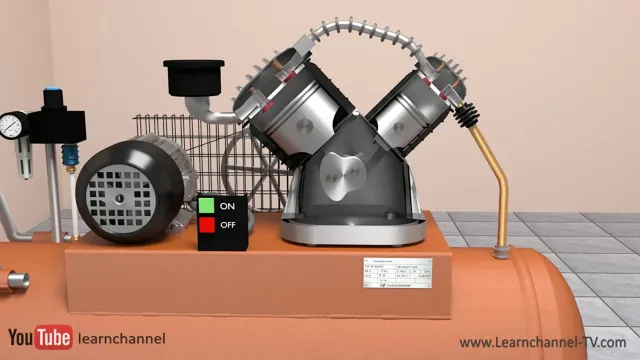
If you’ve ever heard the sound of an air compressor running, you might have wondered how this nifty little machine actually works. Well, wonder no more! In this article, we’ll delve deep into the inner workings of an air compressor and how it produces compressed air that is so useful in a variety of industries and applications. Whether you’re an avid DIY enthusiast or a professional mechanic, understanding how an air compressor works will help you make better use of this indispensable tool in your work or hobby.
So, let’s dive in and explore the magic of air compressors!
Introduction
Air compressors are essential pieces of equipment in a variety of industries. They work by using an electric motor or gas engine to turn a piston or rotor inside a cylinder. As the piston or rotor moves, air is compressed and pushed through a valve into a storage tank, where it can be stored and used for a range of applications.
Air compressors can be used for tasks such as inflating tires and powering tools, and are commonly found in construction sites, auto shops, and factories. One key advantage of air compressors is their ability to operate continuously, providing a steady stream of compressed air to power equipment. They also come in a range of sizes and power levels, making it easy for users to select the right model for their needs.
Overall, understanding how a air compressor works is crucial for anyone working in industries that rely on compressed air for their operations.
Definition of an Air Compressor
Air compressor An air compressor is a machine that converts power into stored energy by compressing and pressurizing air. This stored energy can then be used to power machinery, pneumatic tools, and a wide range of other devices that require compressed air to function. Air compressors come in a variety of shapes and sizes, from small portable units designed for home use to large industrial machines used in manufacturing and construction.
They are commonly used in industries such as automotive repair, construction, and even in the medical field for tasks such as oxygen delivery. Air compressors have become an essential part of modern life, powering everything from nail guns to hospital ventilators.
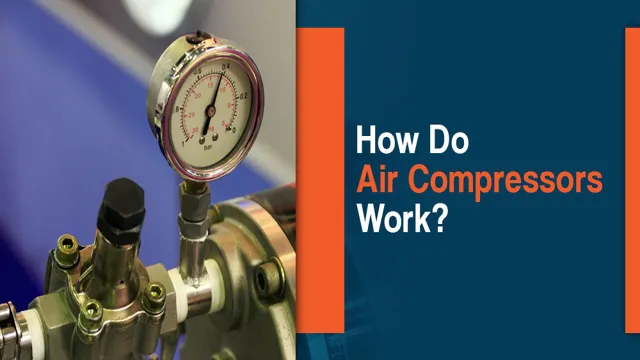
Brief History of Air Compressors
Air compressors have become an integral part of the industrial and commercial world, but have you ever wondered where they came from? The history of air compressors dates back to the 17th century when scientists began experimenting with air pressure and its properties. The first recorded air compressor was created by English physicist Denis Papin in 168 However, it wasn’t until the early 1800s when the first successful compressors were invented, which used steam as a power source.
Fast forward to the 1900s and air compressors had become a crucial part of several industries, including construction, manufacturing, and automotive. With advances in technology, different types of air compressors were developed, such as piston, rotary screw, and centrifugal compressors. Today, air compressors are used in almost every industry imaginable, from refrigeration to medical applications.
The keyword used organically is “air compressors.”
Working Principles
Air compressors are devices that transform power from an electric motor or diesel engine into stored energy in the form of compressed air. Simply put, air compressors work by taking in air from the outside environment and compressing it to a higher pressure. This compressed air can then be used to power various tools and machines, from pneumatic drills to spray guns.
The working principles of air compressors are based on Boyle’s Law, which states that the pressure and volume of a gas are inversely proportional to each other. In other words, as the volume of air decreases, the pressure of the air increases. This is achieved by using a pump-like mechanism that compresses the air and stores it in a tank until it is needed.
The compressed air is then released through a hose or pipe, providing the necessary power for the tool or machine. Overall, air compressors are a vital component in many industries and can greatly increase productivity and efficiency in various applications.
Compression Chamber and Piston
The compression chamber and piston are essential components of many different types of machinery, including air compressors and internal combustion engines. The compression chamber is a sealed container that compresses a gas or liquid to increase its pressure and density, while the piston is a movable component that helps to compress and expand the gas or liquid in the chamber. The compression chamber and piston work together in a cycle to compress and expand the gas or liquid, which can then be used to power a variety of different machines.
Essentially, the compression chamber and piston work like a syringe, with the piston being pulled back to draw in the gas or liquid, and then pushed forward to compress it. This compression and expansion process creates a flow of energy, which can be used to generate power. Overall, the compression chamber and piston are important components in many different types of machinery, and understanding their working principles is essential for anyone who wants to work with compressors or engines.
Pressure Valve and Release Valve
A pressure valve and release valve work on the principle of controlling pressure. A pressure valve is designed to regulate the pressure inside a system, such as a boiler or pressure cooker. When the pressure inside the system exceeds a specific limit, the pressure valve automatically opens, releasing excess pressure and preventing a potential explosion.
On the other hand, a release valve is designed to allow for the controlled release of fluids or gases from a container or system. This is typically done to protect the system from damage or to maintain the system’s pressure within a specific range. In both cases, the valves play a vital role in ensuring safety and preventing damage to equipment or property.
Understanding the working principles of these valves is essential for anyone who works with them and wants to ensure the system they are working with operates effectively and safely.
Motor and Power Source
When it comes to the working principles of a motor and power source, the key players are electric and magnetic fields. Essentially, motors convert electrical energy into mechanical energy, while power sources provide the electrical energy needed for the motors to operate. Electric current flowing through coils of wire within the motor induces a magnetic field, which then interacts with a stationary magnetic field to create rotational motion.
This is why motors often have a rotor and a stator, and why they are sometimes referred to as rotary electrical machines. Meanwhile, power sources can come in many forms, from batteries to generators to solar panels. The key is that they convert one form of energy into electrical energy, such as chemical energy or light energy.
Overall, the working principles of both motors and power sources are fascinating examples of how electricity and magnetism can be harnessed to create motion and power.
Types of Air Compressors
When it comes to understanding how an air compressor works, it’s important to start by understanding the different types available. The most common types of air compressors are the piston compressor, rotary screw compressor, and centrifugal compressor. Each type works differently and is better suited for different applications.
For example, a piston compressor is ideal for low-pressure applications, whereas a centrifugal compressor is better suited for high-pressure applications. Essentially, an air compressor converts power into potential energy stored in pressurized air. The compressor draws in air through an inlet valve and then compresses it using a piston or other mechanism.
The compressed air is then stored in a tank or released through a hose for use in various applications. By understanding the workings of different types of air compressors, you can select the one that best fits your needs and optimize its performance.
Reciprocating Air Compressors
Reciprocating air compressors are one of the most common types of air compressors used in various industrial and residential applications. They use a piston-cylinder arrangement to compress and store the air before it’s released through an outlet valve. These compressors are classified into single-stage and two-stage reciprocating compressors depending on their compression stages.
A single-stage compressor compresses the air in a single stroke of the piston, while a two-stage compressor divides the compression process into two stages for greater efficiency. Reciprocating compressors are known for their high energy efficiency, reliability, and durability, making them perfect for use in heavy-duty applications such as manufacturing, chemical processing, and mining. These compressors also come in various sizes, designs, and power ratings, making it easy to choose one that fits your specific needs.
So if you’re in the market for an air compressor, consider a reciprocating compressor for your business or home workshop.
Rotary Screw Compressors
Rotary Screw Compressors When it comes to selecting an air compressor, there are several types to choose from. Rotary screw compressors stand out because of their efficiency and high output. These compressors use twin screws to compress air, which provides a continuous flow of compressed air.
They are commonly used in industrial applications because of their ability to handle high volumes of air at a consistent pressure. One of the advantages of rotary screw compressors is their energy efficiency. These compressors operate on a constant flow of air, which means they do not have to constantly turn on and off like other compressors.
This reduces wear and tear on the compressor and can result in lower energy costs over time. Another benefit of rotary screw compressors is their reliability. These compressors are designed to run continuously, which makes them ideal for applications where a consistent flow of compressed air is necessary.
They can also run at higher pressures than other types of compressors, making them versatile in their use. Overall, rotary screw compressors are a great choice for those seeking reliable, consistent, and energy-efficient compressed air solutions. Whether you’re looking to power a manufacturing operation or simply inflate tires in a shop, rotary screw compressors are a solid choice.
Centrifugal Compressors
Centrifugal compressors are one of the types of air compressors used in various industrial applications. These compressors work by using centrifugal force to increase the velocity of air before it passes through a diffuser and converts kinetic energy into pressure. Centrifugal compressors are known for their high flow rates and the ability to handle large volumes of air.
They are commonly used in large buildings, power plants, and industrial processes where compressed air is necessary. The key advantage of centrifugal compressors is that they don’t require any lubrication, making them ideal for applications where oil-contaminated air is not acceptable. However, they are typically more expensive and complex than other types of compressors, requiring skilled technicians to maintain and repair.
Overall, centrifugal compressors are a reliable and efficient choice for many industrial applications, delivering high volumes of compressed air without the need for oil lubrication.
Applications of Air Compressors
When it comes to industrial and commercial applications, air compressors are essential tools that provide a steady stream of compressed air. But how does an air compressor actually work? Well, it works by sucking in air from the atmosphere and compressing it through a series of internal mechanisms. The compressed air is then stored in a tank until it is needed for use.
Air compressors are incredibly versatile and are used for a wide range of applications, including powering pneumatic tools, running production machinery, and even inflating tires. Whether you’re a professional mechanic or just someone who likes to work on DIY projects at home, an air compressor is a tool that you’re going to want to have in your arsenal. So, the next time you’re using a pneumatic wrench or inflating a tire, just remember that it’s all thanks to the power of compressed air, made possible by an air compressor.
Industrial Applications
Air compressors have a wide range of industrial applications, making them an essential piece of equipment across various sectors. One common application of an air compressor is in pneumatic systems, where compressed air is used to power tools and machinery. This includes sandblasting, spray painting, and drilling, among others.
Air compressors are also used in refrigeration and air conditioning systems to control the temperature and humidity levels in a space. In the manufacturing industry, air compressors play a crucial role in powering assembly lines, packaging machinery, and conveyor belts. They are also used to move materials through pneumatic conveyors, saving time and reducing labor costs.
Another area where air compressors are utilized is in the medical field, where they help power ventilators and other life-saving equipment. Air compressors are incredibly versatile, and their ability to operate in different environments make them a valuable asset across a wide range of industries.
Medical Applications
Air compressors have many medical applications that are commonly used in health care facilities. For starters, they are utilized to power medical equipment such as nebulizers, dental drills, and oxygen concentrators. Air compressors can also manage air pressure for respiratory patients, especially those that need breathing assistance.
Additionally, dental clinics adopt air compressors to manage dental tools, power dental chairs, and maintain sterilization standards. Moreover, air compressors are used to clean medical instruments, suction body fluids during surgeries, and regulate the air pressure in medical pneumatic systems. Overall, air compressors are essential devices in the medical industry, greatly contributing to the efficient and effective delivery of quality healthcare services.
Automotive Applications
Air compressors play a critical role in the automotive industry. They are widely used for a variety of applications, including powering air tools, inflating tires, and even sandblasting. Air compressors can generate high-pressure air, which is crucial for many auto repair jobs that require precision and power to get the job done right.
The automotive industry relies heavily on air compressors to help maintain an efficient and safe workspace. One of the most common uses of air compressors in the auto industry is for painting cars. They can provide the necessary air pressure to power the paint gun and create a smooth, even finish.
Without air compressors, paint jobs would be much more difficult and time-consuming. Additionally, air compressors are also used in the operation of pneumatic lifts and jacks, which are crucial for lifting and supporting heavy vehicles during repairs and maintenance. In short, air compressors are vital tools in the automotive industry, helping technicians to perform a wide range of tasks more safely and efficiently.
Conclusion
In conclusion, an air compressor is like the ultimate motivational speaker for compressed air. It takes in the timid and scattered air molecules and pumps them up to reach their full potential. With a burst of energy, the compressed air can power anything from a simple nail gun to an industrial air turbine.
So, next time you hear the hiss of an air compressor, remember that it’s not just air being compressed, it’s potential energy waiting to be unleashed. Keep your tools and machines at the peak of their game, and thank your trusty compressor for being the coach that made it all possible.”
FAQs
What is an air compressor and how does it work?
An air compressor is a machine that converts power into potential energy stored in pressurized air. It works by pulling in air from the atmosphere and compressing it to a higher pressure to be used for various purposes such as powering tools or inflating tires.
What are the different types of air compressors?
There are three main types of air compressors: reciprocating, rotary screw, and centrifugal compressors. Reciprocating compressors use a piston and cylinder to compress air, rotary screw compressors use two helical screws to compress air, and centrifugal compressors use a spinning impeller to increase air pressure.
What are the advantages of using an air compressor?
Using an air compressor provides several advantages, including reliable power source, efficient operation, and versatility in application. Air compressors can be used for powering pneumatic tools, spraying paint, inflating tires, and much more.
How do you maintain an air compressor?
To maintain an air compressor, it is important to regularly check and replace air filters, drain water from tanks, change compressor oil, and ensure proper belt tension. Proper maintenance can help prolong the life of the compressor and prevent costly repairs.
Can an air compressor be used to power a car engine?
No, an air compressor alone cannot power a car engine. However, compressed air can be used in conjunction with a car engine to power pneumatic tools and other equipment.
How is the pressure of the compressed air controlled?
The pressure of the compressed air is controlled by a pressure switch that turns the compressor on and off based on the predetermined pressure settings. This helps maintain consistent air pressure for various applications.
What safety precautions should be taken when using an air compressor?
Some safety precautions when using an air compressor include wearing eye and ear protection, avoiding direct contact with compressed air, and properly grounding the compressor to prevent electrical shock. It is also important to ensure the compressor is properly maintained and operated according to manufacturer instructions.

